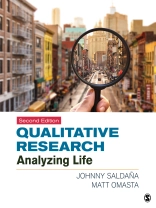Qualitative Research: Analyzing Life, Second Edition presents a fresh approach to teaching and learning qualitative methods for social inquiry—one that focuses on analysis from the very beginning of the text. By exploring qualitative research through a unique analytic lens, then cumulatively elaborating on methods in each successive chapter, this innovative work cultivates a skill set and literacy base that prepares readers to work strategically with empirical materials in their own fieldwork. Johnny Saldaña and Matt Omasta combine clear, accessible writing and analytic insight to show that analysis, in its broadest sense, is a process undertaken throughout the entire research experience. The Second Edition provides a number of updates including more on digital materials and methods, including sentiment analysis of social media data, and ethics in social media research.
Resources for instructors and students are available on a website to accompany the book.
Tabela de Conteúdo
List of Displays
Preface
The Organization and Through-Line of the Book
The Coauthors’ Approach
To the Instructor
Acknowledgments
About the Authors
Part I. Analyzing Qualitative Data
Chapter 1. Introduction: Analyzing Life
Learning Objectives
Introduction
Developing Fundamental Qualitative Analytic Skills
On Qualitative Data Analysis—and Life
Closure and Transition
Resources for an Introduction to Qualitative Analysis
Analytic Exercises
Sample Data for Analysis
Chapter 2. Analyzing Field Sites
Learning Objectives
Introduction
On Culture
Observation Settings
The Observer’s Frames
Field Notes
Technical Matters of Fieldwork and Field Notes
Analyzing Observations of Social Life
Closure and Transition
Resources for Participant Observation
Analytic Exercises for Participant Observation
Sample Field Notes for Analysis
Chapter 3. Analyzing Documents, Artifacts, Visual Images, and Digital Materials
Learning Objectives
Introduction
On Values, Attitudes, and Beliefs
Analyzing Manifest and Latent Contents
The Materials and Meanings of Human Production
Analyzing Documents
Analyzing Artifacts
Analyzing Visual Images
Analyzing Digital Materials
The Routines, Rituals, Rules, Roles, and Relationships in Documents, Artifacts, Visual Images, and Digital Materials
Closure and Transition
Resources for Analyzing Documents, Artifacts, Visual Images, and Digital Materials
Analytic Exercises for Documents, Artifacts, Visual Images, and Digital Materials
Sample Photograph
Chapter 4. Analyzing Interviews: Preparing, Conducting, and Transcribing
Learning Objectives
Introduction
Types of Interviews
Participant Selection
Interview Preparation, Scheduling, and Arrangements
Asking Questions
Transcribing
Closure and Transition
Resources for Interviewing
Analytic Exercises for Interviewing
Chapter 5. Analyzing Interviews: Condensing and Coding
Learning Objectives
Introduction
Interview Condensation
Analyzing Interviews Through Codes and Coding
Closure and Transition
Analytic Exercises for Interviewing
Sample Interview Transcript
Part II. Analyzing the Framework
Chapter 6. Analyzing Qualitative Methodologies
Learning Objectives
Introduction
Theoretical Premises of Qualitative Research
A Rationale for Qualitative Research
Selected Methodologies of Qualitative Research and Analysis
Mixed Methods
On Genres
Closure and Transition
Resources for Analyzing Qualitative Research Methodologies
Analytic Exercises for Qualitative Research Methodologies
Supplemental Readings
Chapter 7. Analyzing Qualitative Research Design
Learning Objectives
Introduction
Researching and Analyzing the Topic
Analyzing the Literature
Research Questions
Site Selection
Participant Selection
Data Collection Methods
Data Analysis Methods
Presentation Modes
Timeline Design
Conceptual Frameworks
Closure and Transition
Resources for Analyzing Qualitative Research Design
Analytic Exercises for Qualitative Research Design
Outline for a Qualitative Research Proposal
Chapter 8. Analyzing Research Ethics
Learning Objectives
Introduction
The Rules of Research
Institutional Review Boards
Researcher and Participant Relationships
Ethics in Social Media Research
Analyzing Ethical Ambiguity
Closure and Transition
Resources for Research Ethics
Analytic Exercises for Research Ethics
Part III. Analytic Assemblage
Chapter 9. Analysis to Synthesis: Condensing, Patterning, and Unifying
Learning Objectives
Introduction
On Synthesis
Condensing Large Amounts of Data
Patterning Textual, Visual, and Digital Materials
Unifying Seemingly Different Things
Closure and Transition
Analytic Exercises for Analysis to Synthesis
Chapter 10. Analysis to Synthesis: Understanding, Interpreting, and Theorizing
Learning Objectives
Introduction
Understanding Social Processes of Human Action, Reaction, and Interaction
Interpreting the Routines, Rituals, Rules, Roles, and Relationships of Social Life
Theorizing
CAQDAS
On Credibility and Trustworthiness
Closure and Transition
Resources for Analysis to Synthesis
Analytic Exercises for Analysis to Synthesis
Sample Data for Analysis to Synthesis
Chapter 11. Analytic Write-Ups
Learning Objectives
Introduction
Stylistic Approaches to Research Writing
On Writing About the Major Elements of a Study
Journal Article Submission and Publication
Closure and Transition
Resources for Analytic Write-Ups
Analytic Exercises for Write-Ups
Sample Abstracts for Analysis
Chapter 12. Analytic Presentations and Professional Development
Learning Objectives
Introduction
Paper Presentations
Poster Presentations
Dramatic/Staged Readings
Presenting Data Effectively
Professional Networking
Professional Development
Analysis as a Lens, Filter, and Angle on Life
Closure
Resources for Presenting Qualitative Research and Professional Development as a Qualitative Researcher
Analytic Exercises for Presentations and Professional Development
Glossary
References
Index
Sobre o autor
Matt Omasta is Associate Professor and Theatre Education Program Director at Utah State University. He received his BA from Ithaca College, his MA from Emerson College, and his Ph D from Arizona State University. He is the author of Play, Performance, and Identity: How Institutions Structure Ludic Spaces (Routledge), Playwriting and Young Audiences (Intellect), and numerous articles in journals including Research in Drama Education: The Journal of Applied Theatre and Performance, Youth Theatre Journal, Theatre for Young Audiences Today, Theatre Topics, and the International Journal of Education and the Arts among others. Omasta′s work has been recognized by honors including the Founders′ Award from the Educational Theatre Association, the Lin Wright Special Recognition Award and the Research Award from the American Alliance for Theatre & Education, and the Arts and Learning Special Interest Group (A & L SIG) Dissertation Award from the American Educational Research Association (AERA).












